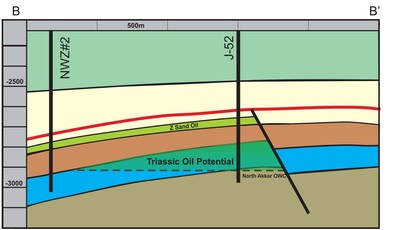Jupiter’s Block 31 shown on Figure 1 is amongst the producing fields of the basin. The 1st well on the Contract Area (NWZ 2) was drilled by the Soviets in 1969. Jupiter has since drilled nine new wells since purchasing the licence in 2008. The first eight wells - J-50 (2009), J-52 (2010), J-51 (2011), J-53 (2012), J-55 (2012), J-58 (2012), J-59 (2013) and Well 19 (2014) all discovered oil. The most recent well (J-57) was not successful in identifying hydrocarbons.
The J-55, J-58 and J-59 wells are all located in the new West Zhetybai field to the south of the already discovered Akkar East field. The Akkar East field has been delineated by the J-51, J-52, J-53 and #19 wells. The J-50 well is located on Akkar North (East Block) (see Fig 4 below).
Independently verified reserves have, to date, been encountered in the Mid Triassic Carbonates.
The Kazakhstan reserves classification system, which has been developed from the Russian classifications, divides geological (in-place) and recoverable reserves into various categories including C1 and C2. The basis for the evaluation, and categorisation, is the geological data set, the C1/C2 classification system does not take into consideration the commercial factors impacting the development of the identified C1 and C2 reserves. Current State approved preliminary C1/C2estimates for Block 31 are:
- C1+C2: ~52.33 mmbbls
- C1: ~34.65 mmbbls
- C2: ~17.68 mmbbls
Under the SPE’s Petroleum Resources Management System (PRMS) reserves are defined as those quantities of oil (and gas) which are estimated to be commercially recovered from a known accumulation from a given date forward, i.e. determined on the geological and commercial data set. Jupiter recently engaged Sproule International Limited to evaluate the Proved, Probable and Possible reserves for the Company’s three oilfields in Kazakhstan and to prepare a CPR as to its findings – effective 31 December 2023. In summary the recoverable reserves associated with Jupiter’s fields in Kazakhstan are currently:
- Proved Reserves: 1P 14.691 mmbbls
- Proved plus Probable Reserves: 2P 36.487 mmbbls
- Proved plus Probable plus Possible: 3P 46.796
mmbbls

Fig 4 – Mid Triassic Northeast Akkar Oil Field
J-50 and J-52 penetrated a 100-120m Mid Triassic Carbonate section which was wholely oil saturated. J-51 penetrated a 160m section. J-53 confirmed approximately 87m of gross and 56m of net pay at the Middle Triassic carbonate reservoir unit. Core, wireline logs and flow testing suggests about half the section is productive in all wells. The field is mapped to extend over an area of ~14 sq km.
Fig 5 – Mid Triassic Northeast Akkar Oil Field with line of section
Fig 6 – J-50 Dip Section
J-52 encountered the Lower Jurassic which flowed oil in NWZ#2 in an updip position. This 25m sand was oil saturated on logs and core but when flow tested it was shown that it may not be viable for commercial production. It is expected that there will be further testing of this reservoir during future drilling programs.
Fig 7 – NWZ#2 to J-52 Dip Section



